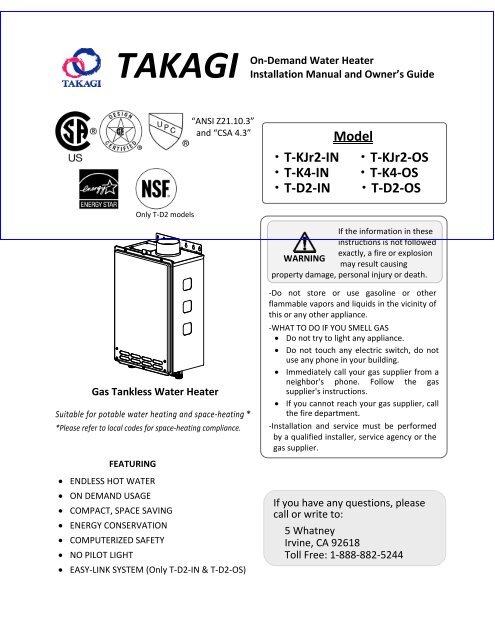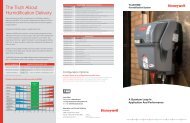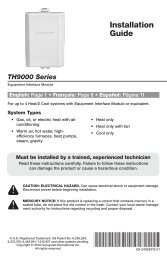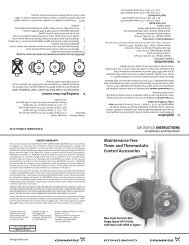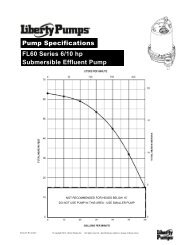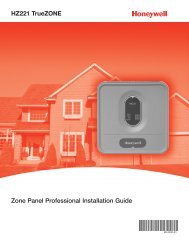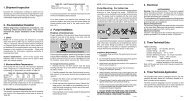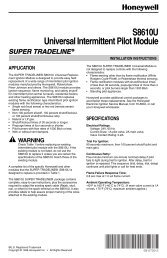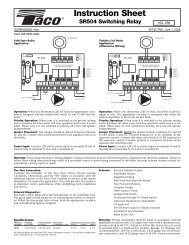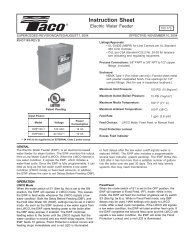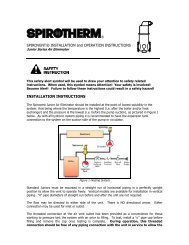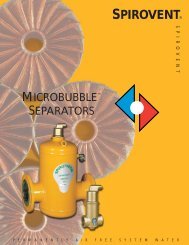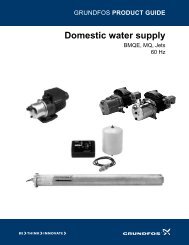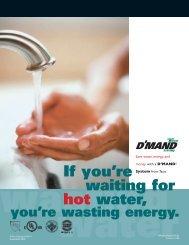TAKAGI - PEX Universe
TAKAGI - PEX Universe
TAKAGI - PEX Universe
You also want an ePaper? Increase the reach of your titles
YUMPU automatically turns print PDFs into web optimized ePapers that Google loves.
<strong>TAKAGI</strong>On‐Demand Water HeaterInstallation Manual and Owner’s Guide“ANSI Z21.10.3”and “CSA 4.3”Model・T‐KJr2‐IN ・T‐KJr2‐OS・T‐K4‐IN ・T‐K4‐OS・T‐D2‐IN ・T‐D2‐OSOnly T‐D2 modelsIf the information in theseinstructions is not followedexactly, a fire or explosionWARNINGmay result causingproperty damage, personal injury or death.Gas Tankless Water HeaterSuitable for potable water heating and space‐heating **Please refer to local codes for space‐heating compliance.FEATURING• ENDLESS HOT WATER• ON DEMAND USAGE• COMPACT, SPACE SAVING• ENERGY CONSERVATION• COMPUTERIZED SAFETY• NO PILOT LIGHT• EASY‐LINK SYSTEM (Only T‐D2‐IN & T‐D2‐OS)‐Do not store or use gasoline or otherflammable vapors and liquids in the vicinity ofthis or any other appliance.‐WHAT TO DO IF YOU SMELL GAS• Do not try to light any appliance.• Do not touch any electric switch, do notuse any phone in your building.• Immediately call your gas supplier from aneighbor's phone. Follow the gassupplier's instructions.• If you cannot reach your gas supplier, callthe fire department.‐Installation and service must be performedby a qualified installer, service agency or thegas supplier.If you have any questions, pleasecall or write to:5 WhatneyIrvine, CA 92618Toll Free: 1‐888‐882‐5244
CONTENTSInstallation ManualContentsSPECIFICATIONS…………………………………………………………………………………………..………………………... 3INTRODUCTION…………………………………………………………………………………………………..…………………. 4SAFETY GUIDELINES…………….………………………………………………………………………………………..……….. 5INSTALLATION………………………………………………………………………………………………..…………………..…. 6General………………………………………………………………………………………………………………………..…..… 6Clearances…………………………………………………………………………………………………………………………… 8Included Accessories…………….………………………………………………………………………………………..….. 8Optional Items…………………………………………………………………………………………………………………….. 9High‐Altitude Installations……………………………………………………………………………………………………. 11Venting Instructions…………………………………………………………………………………………………………….. 12Gas Supply and Gas Pipe Sizing………......................................................................................… 17Water Connections……………..…………………………………………………………………………………………….… 20Electrical Connections……………………………………………………………………..……………………………....... 21Remote Controller Connections.……..……………………………………………………………………………….… 22Pump Control Mode (Only T‐D2‐IN & T‐D2‐OS)………………………….……………………………….……… 23Easy‐Link System (Only T‐D2‐IN & T‐D2‐OS)…….……………………...…………………………………..….... 24APPLICATIONS...……………………………………………………………………………………………………………………… 28INITIAL OPERATION..………………………………………………………………………………………………………….…… 30Owner’s GuideOPERATING SAFETY………………………………………………………………………………………………………………… 31NORMAL OPERATION…………………………………………………………………………………………………………..… 33General………..……….………….………………………………………………………………………………………………… 33Temperature Settings.…….……..…………………………………………………………………………………………… 33Flow……………………………………………………………………………………………………………………………………. 35Freeze Protection System…….…………………………………………………………………………………………..… 35Maintenance and Service………………………………………………………………………………………………….… 36Unit Draining and Filter Cleaning………………………………………………………………………………………… 36TROUBLESHOOTING……..……………………………………………………………………………………………………..… 37General………..……….………….………………………………………………………………………………………………… 37Error Codes.…………………….…..……………………………………………………………………………………………… 39COMPONENTS DIAGRAM……………………………………………………………………………………………………..… 42PARTS LIST………………….………………………………………………………………………………………………..………… 46OUTPUT TEMPERATURE CHART…………………………………………………………………………………………...… 48PRODUCT REGISTRATION AND LIMITED WARRANTY…………....…………………………………………….…… 502│Page
SPECIFICATIONSInstallation ManualSpecificationsModel T‐KJr2‐IN T‐KJr2‐OS T‐K4‐IN T‐K4‐OS T‐D2‐IN T‐D2‐OSNatural Gas InputMin: 19,500 Btu/hMin: 11,000 Btu/hMin: 11,000 Btu/h(Operating Range)Max: 140,000 Btu/hMax: 190,000 Btu/hMax: 199,000 Btu/hPropane Input(Operating Range)Min: 19,500 Btu/hMax: 140,000 Btu/hMin: 11,000 Btu/hMax: 190,000 Btu/hMin: 11,000 Btu/hMax: 199,000 Btu/hGas Connection¾” NPTWater Connections¾” NPTWater Pressure15 ‐ 150 psi*Natural GasInlet PressureMin. 5.0” WCMax. 10.5” WCPropaneInlet PressureMin. 8.0” WCMax. 14.0” WCManifoldPressure**Natural 2.0” WC 2.5” WC 2.0” WC 2.5” WC 2.0” WC 2.5” WCPropane 2.5” WC 3.1” WC 3.7” WC 4.0” WC 3.7” WC 4.5” WCWeight 28.7 lbs. 34.6 lbs.Dimensions H20.5” x W13.8” x D6.7” H20.5” x W13.8” x D8.5”IgnitionSupplyElectric Ignition120 VAC / 60 HzElectricConsumptionOperation 73.1 W / 0.61 A 87.6 W / 0.73 A 89.8 W / 0.75 AStandby 6.2 W / 0.05 A 6.2 W / 0.05 A 6.2 W / 0.05 AFreeze‐Protection111 W / 0.93 A 111 W / 0.93 A 111 W / 0.93 A*40 psi or above is recommended for maximum flow.**The Manifold Pressure is the factory setting and generally should not need adjustment.NOTE:• Check the rating plate to ensure this product matches your specifications.• In accordance with ANSI Z21.10.3, CO emission does not exceed 400 PPM fornormal input.• The manufacturer reserves the right to discontinue, or change at any time,specifications or designs without notice and without incurring obligations.3│Page
INTRODUCTIONIntroduction• This manual provides information necessary for the installation, operation, andmaintenance of the water heater.• The model description is listed on the rating plate which is attached to the front panelof the water heater.• Please read all installation instructions completely before installing this product.• If you have any problems or questions regarding this equipment, consult with themanufacturer or its local representative.• This equipment is an on‐demand, tankless water heater designed to efficiently supplyendless hot water for your needs.• The T‐KJr2‐IN, T‐K4‐IN, & T‐D2‐IN are to be only installed indoor (direct‐ventconvertible). The T‐KJr2‐OS, T‐K4‐OS, & T‐D2‐OS are to be only installed outdoor.• The principle behind tankless water heaters is simple:*This diagramillustrates tanklesswater heater designconcepts only anddoes not accuratelyrepresent to the waterheater’s physicaldescription.1. A hot water tap is turned on.2. Water enters the heater.3. The water flow sensor detects the water flow.4. The computer initiates the fan motor and sends a signal to the igniter to create an ignitionspark.5. The gas ignites and flames appear within the burner chamber.6. Water circulates through the heat exchanger and then gets hot.7. Using thermistors to measure temperatures throughout the water heater, the computermodulates the gas and water valves to ensure proper output water temperature.8. When the tap is turned off, the unit shuts down.4│Page
SAFETY GUIDELINESSafety GuidelinesSAFETY DEFINITIONSDANGERIndicates an imminently hazardous situation which, if not avoided, will result indeath or serious injury.WARNINGIndicates an imminently hazardous situation which, if not avoided, could resultin death or serious injury.CAUTIONIndicates an imminently hazardous situation which, if not avoided, could resultin minor or moderate injury.GENERAL1. Follow all local codes, or in the absence of local codes, follow the most recent edition of theNational Fuel Gas Code: ANSI Z223.1/NFPA 54 in the USA or CAN/CSA B149.1 Natural Gas, PropaneInstallation Code in Canada.2. Properly ground the unit in accordance with all local codes or in the absence of local codes, withthe National Electrical Codes: ANSI/NFPA 70 in the USA or CSA standard C22.1 Canada ElectricalCode Part 1 in Canada.3. Carefully plan where you intend to install the water heater. Please ensure:• Your water heater will have enough combustible air and proper ventilation.• Locate your heater where water leakage will not damage surrounding areas (please referto p. 7).4. Check the rating plate for the correct GAS TYPE, GAS PRESSURE, WATER PRESSURE and ELECTRICRATING.*If this unit does not match your requirements, do not install and consult with themanufacturer.5. If any problem should occur, turn off all hot water taps and turn off the gas. Then call a trainedtechnician or the Gas Company or the manufacturer.WARNING• Water temperatures over 125°F (52°C) can cause severe burns instantly or deathfrom scalding. The water temperature is set at 122°F (50°C) from the factory tominimize any scalding risk. Before bathing or showering always check the watertemperature.• Do not store or use gasoline or other flammables, vapors, or liquids in the vicinityof this appliance.• Do not reverse the water and/or gas connections as this will damage the gasvalves and can cause severe injury or death. Follow the diagram on p. 20 wheninstalling your water heater.• Do not use this appliance if any part has been in contact with or been immersedin water. Immediately call a licensed plumber, a licensed gas fitter, or aprofessional service technician to inspect and/or service the unit if necessary.• Do not disconnect the electrical supply if the ambient temperature will dropbelow freezing. The Freeze Prevention System only works if the unit has electricalpower. The warranty will not be covered if the heat exchanger is damaged due tofreezing. Refer to the section on the Freeze Prevention System on p. 35 for moreinformation.5│Page
INSTALLATIONGENERALInstallation1. Follow all local codes, or in the absence of local codes, follow the most recent edition of theNational Fuel Gas Code: ANSI Z223.1/NFPA 54 in the USA or CAN/CSA B149.1 Natural Gas,Propane Installation Code in Canada.2. All gas water heaters require careful and correct installation to ensure safe and efficientoperation. This manual must be followed exactly. Read the “Safety Guidelines” section.3. The manifold gas pressure is preset at the factory. It is computer controlled and should notneed adjustment.4. Maintain proper space for servicing. Install the unit so that it can be connected or removedeasily. Refer to the Clearances Section on p. 8 for proper clearances.5. The water heater must be installed in a location where the proper amount of combustible airwill be available to it at all times without obstructions.6. The electrical connection requires a means of disconnection, to terminate power to the waterheater for servicing and safety purposes.7. Do not install the unit where the exhaust vent is pointing into any opening in a building or wherethe noise may disturb your neighbors. Make sure the vent termination meets the requireddistance by local code from any doorway or opening to prevent exhaust from entering a building(refer to p. 15).8. Particles from flour, aerosols, and other contaminants may clog the air vent or reduce thefunctions of the rotating fan and cause improper burning of the gas. Regularly ensure that thearea around the unit is dust‐ or debris‐free; regular maintenance is recommended for thesetypes of environment.9. If you will be installing the water heater in a contaminated area with a high level of dust, sand,flour, aerosols or other contaminants/chemicals, they can become airborne and enter and buildup within the fan and burner causing damage to the water heater.10. For the T‐KJr2‐IN, T‐K4‐IN, and T‐D2‐IN models:• These units may be converted to a direct‐vent (sealed combustion) appliance by installing adirect‐vent conversion kit (Part No. TK‐TV10) which will bring in all required combustible airfrom outside the building. When installing the TK‐TV10 conversion kit, please follow allinstructions included with the kit.• If the water heater is used as a direct‐vent appliance, the unit requires a 3” combustible airsupply pipe. The intake pipe must be sealed airtight. Air supply pipe can be made of ABS,PVC, galvanized steel, corrugated aluminum, corrugated stainless steel or Category IIIstainless steel.• Terminating the venting through a sidewall is recommended for the direct‐vent system.• Running the exhaust vent and the intake pipe parallel is recommended.• Terminating the exhaust and intake on the same wall / surface is recommended.Terminating in the same pressure zone allows for pressure balancing, which preventsnuisance shutdowns.11. For T‐KJr2‐OS, T‐K4‐OS, & T‐D2‐OS:• To be installed outdoors and only in areas with mild, temperate climates.6│Page
InstallationWARNINGCAUTION• Installation and service must be performed by a qualified installer (forexample, a licensed plumber or gas fitter), otherwise the warranty will bevoid.• The installer (licensed professional) is responsible for the correct installationof the water heater and for compliance with all national, state/provincial,and local codes.• The manufacturer does not recommend installing the water heater in a pit orlocation where gas and water can accumulate.• Do not have the vent terminal pointing toward any operating window, door, oropening into a building.• Do not install next to any source of airborne debris, such as a clothes dryer,that can cause debris to be trapped inside the combustion chamber, unlessthe system is direct‐vented.• The manufacturer does not recommend installing the water heater in anattic due to safety issues. If you install the water heater in an attic:• Make sure the unit will have enough combustion air and proper ventilation.• Keep the area around the water heater clean. When dust collects on theflame sensor, the water heater will shut down on an error code.• If the above conditions cannot be met, use the direct vent conversion kitTK‐TV10.• Place the unit for easy access for service and maintenance.• A drain pan, or other means of protection against water damage, isrequired to be installed under the water heater in case of leaks.• The warranty will not cover damage caused by water quality.• Only potable water or potable water / glycol mixtures can be used with thiswater heater. Do not introduce pool or spa water, or any chemicallytreated water into the water heater.• Water hardness levels must not exceed 7 grains per gallon (120 ppm) forsingle family domestic applications or more than 4 grains per gallon (70ppm) for all other types of applications. Water hardness leads to scaleformation and may affect/damage the water heater. Hard water scalingmust be avoided or controlled by proper water treatment.• Water pH levels must be between 6.5 and 8.5• Well water must be treated.• Do not install the unit where water, debris, or flammable vapors may get intothe flue terminal.• The manufacturer recommends using the direct vent kit when the waterheater is installed in a beauty salon. Some chemicals used in a beauty salonmay affect the flame sensor. Water heater may not work properly.• Although the water heater is designed to operate with minimal sound, themanufacturer does not recommend installing the unit on a wall adjacent to abedroom, or a room that is intended for quiet study or meditation, etc.• Locate your heater close to a drain where water leakage will not do damage tosurrounding areas. As with any water heating appliance, the potential forleakage at some time in the life of the product does exist. The manufacturerwill not be responsible for any water damage that may occur. If you install adrain pan under the unit, ensure that it will not restrict the combustion airflow.7│Page
CLEARANCESTopInstallationMaintain all clearances aroundthe water heater.SideBackSideFrontBottomModel Top Bottom Front Back SidesT‐KJr2‐IN* 12” 12” 24” 1” 2 “T‐KJr2‐OS 36” 12” 24” 1” 2 “Model Top Bottom Front Back SidesT‐K4‐IN* 12” 12” 24” 1” 2 “T‐K4‐OS 36” 12” 24” 1” 2 “Model Top Bottom Front Back SidesT‐D2‐IN* 12” 12” 24” 1” 2 “T‐D2‐OS 36” 12” 24” 1” 2 “*Standard indoor installations & direct‐vent indoor installations have the same clearances.INCLUDED ACCESSORIESCheck that these items below are included with the water heater.1. Installation Manual &Owner’s Guide2. Product Registration Card 3. Communication Cable(Only T‐D2‐IN & T‐D2‐OS models)Qty: 1 Qty: 1 Qty: 18│Page
OPTIONAL ITEMSInstallationModel T‐KJr2‐IN T‐KJr2‐OS T‐K4‐IN T‐K4‐OS T‐D2‐IN T‐D2‐OSTK‐RE02 ✔ ✔ ✔ ✔TM‐RE30 ✔ ✔TK‐BF01 ✔ ✔ ✔TK‐TV10 ✔ ✔ ✔TK‐PC01 ✔ ✔ ✔ ✔TK‐PCJr2 ✔ ✔TK‐RB02 ✔ ✔ ✔TK‐KPWL4TK‐KPWH4✔ ✔ ✔TK‐KPCT43 ✔ ✔ ✔1. Temperature Remote Controller: TK‐RE02The Temperature RemoteController has two functions. Itallows the output temperaturefrom the water heater to beadjusted within the range of99 °F to 167 °F, and it alsoworks as a diagnostic tool that will give a conciseerror code whenever there is a problem with theunit. The temperature options are 99°F, 100°F,102°F, 104°F, 106°F, 108°F, 109°F, 111°F, 113°F,115°F, 117°F, 122°F, 131°F, 140°F, 158°F, and167°F. See the trouble shooting section forinformation on possible error codes.3. Backflow Preventer: TK‐BF01The Backflow preventer preventsthe backflow of air through theexhaust vent. This helps preventharmful exhaust gases fromentering the home, as well ashelping to prevent the unit from freezing in areaswhere cold air can be blown or drawn into theexhaust system. Install this vent damper inaccordance with the installation instructions andany applicable codes.2. Temperature Remote Controller: TM‐RE30The Temperature RemoteController has two functions. Itallows the output temperaturefrom the water heater to beadjusted within the range of 99°F to 185 °F, and it also works asa diagnostic tool that will give a concise error codewhenever there is a problem with the unit. Thetemperature options are 99°F, 100°F, 102°F,104°F, 106°F, 108°F, 110°F, 111°F, 113°F, 115°F,117°F, 122°F, 131°F, 140°F, 149°F, 158°F, 167°F,176°F and 185°F. See the trouble shooting sectionfor information on possible error codes.4. Direct‐Vent Conversion Kit: TK‐TV10This kit can be used toconvert the waterheater from astandard vent systemto a direct‐vent (orsealed combustion)system. Install thisconversion kit in accordance with the installationinstructions and any applicable codes.9│Page
5. Pipe Covers: TK‐PC01 and TK‐PCJr2The pipe cover protects theplumbing pipes to the water heaterfrom unexpected adjustments.This pipe cover is fixed to thebottom of the water heater, whichhides the plumbing and improvesthe visual aspects of the wholeinstallation for the water heater.7. T‐Vent Wall Thimble with Termination: TK‐KPWL4 and TK‐KPWH4Installation6. Recess box: TK‐RB02The Recess box will allow for“clean” installations. The waterheater fits inside the recess box,which hides and protects thewhole water heater and plumbing.The Recess box will fit in‐betweenmost wall studs.LouverTerminationTK‐KPWL4HoodTerminationTK‐KPWH4These terminations are used when venting out through the walland are compatible with the T‐Vent pipe system.These terminations are special stainless steel vents for gasappliances and are UL listed as Category II, III and IV. There aretwo types of terminations: the Louver termination and the Hoodtermination. For different wall thicknesses, there are two rangesof lengths available (refer to the T‐Vent brochure for details).Install these vent terminations in accordance with theirinstallation instructions and any applicable local codes.8. Direct‐Vent Concentric Termination: TK‐KPCT43Used when terminating direct‐vent (sealed‐combustion) systems,with direct‐vent models that require a 3” intake and a 4” exhaust.This concentric termination provides the convenience of onlyhaving to make one penetration through a sidewall instead of twoseparate penetrations for the intake and exhaust piping. Thetermination includes a bird screen, restricting small animals,pests, and foreign objects from entering into the vent system.This sidewall termination is available in three different sizes, tocover all ranges of wall thicknesses.Direct‐vent Concentric TerminationPart#Covering wall thicknessTK‐KPCT43‐1 3.9” – 7.1”TK‐KPCT43‐2 6.9” – 10.1”TK‐KPCT43‐3 9.8” – 13.0”10│Page
InstallationHIGH‐ALTITUDE INSTALLATIONSCheck the elevation where your water heater is installed. Set dipswitches shown in the table belowdepending on the altitude.T‐KJr2‐IN/OS & T‐K4‐IN/OS0 to 2,000 ftAltitude2,000 to 4,000 ft 4,000 to 6,000 ft Over 6,000 ft(DEFAULT)Switch No.3 OFF ON OFFConsultSwitch No.4 OFF OFF ONour TechnicalServicesDepartmentat 1‐888‐882‐5244ON 1 2 3 4 5 6 7 8OFFOFFON 1 2 3 4 5 6 7 8 OFFON 1 2 3 4 5 6 7 8T‐D2‐IN/OS (Left bank of dipswitches)0 to 2,000 ftAltitude2,000 to 4,000 ft 4,000 to 6,000 ft Over 6,000 ft(DEFAULT)Switch No.4 OFF ON OFFConsultSwitch No.5 OFF OFF ONour TechnicalServicesDepartmentat 1‐888‐882‐5244ON 1 2 3 4 5 6OFFOFFON 1 2 3 4 5 6 OFFON 1 2 3 4 5 6T‐KJr2‐IN/OS & T‐K4‐IN/OS Computer boardT‐D2‐IN/OS Computer boardDipswitchesLeft bank of dipswitchesWARNING• DO NOT adjust any dipswitches on the right bank for the T‐D2‐IN/OSmodels.• The dark squares indicate the direction the dipswitches should be set to.11│Page
VENTING INSTRUCTIONS‐General‐InstallationImproper venting of this appliance can result in excessive levels of carbonmonoxide which can result in severe personal injury or death.DANGERImproper installation can cause nausea or asphyxiation, severe injury or death fromcarbon monoxide and flue gases poisoning. Improper installation will void productwarranty.CAUTIONWhen installing the vent system, all applicable national and local codes must befollowed. If you install thimbles, fire stops or other protective devices and theypenetrate any combustible or noncombustible construction, be sure to follow allapplicable national and local codes.The water heater must be vented in accordance with the section “Venting of Equipment" of the latestedition of the National Fuel Gas Code: ANSI Z223.1/NFPA 54 in the United States and/or Section 7 of theCAN/CSA B149.1 Natural Gas and Propane Installation Code in Canada, as well as applicable localbuilding codes.The manufacturer recommends the “T‐Vent” line manufactured by <strong>TAKAGI</strong> (Refer to “T‐Vent”brochure for details). However, the following are also UL listed manufacturers: ProTech Systems Inc.(FasNSeal), Flex‐L Inc., Z‐Flex Inc. (Z‐Vent III), Metal‐Fab Inc., and Heat‐Fab Inc. (Saf‐T Vent).General rules for venting water heaters are:• Place the water heater as close as possible to the vent terminator.• The vent collar of the water heater must be fastened directly to an unobstructed vent pipe.• Do not weld the vent pipe to the water heater’s vent collar.• Do not cut the vent collar of the unit.• The vent must be easily removable from the top of the water heater for normal service andinspection of the unit.• The water heater vent must not be connected to any other gas appliance or vent stack.• Avoid using an oversized vent pipe or using extremely long runs of the pipe.• For rooftop venting, a rain cap or other form of termination that prevents rain water fromentering into the water heater must be installed.• Do not common vent or connect any vent from other appliances to the water heater vent.General rules for vent terminations:• Avoid locating the water heater vent terminator near any air intake devices. These fans canpick up the exhaust flue products from the water heater and return them to the building.This can create a health hazard.• Locate the vent terminator so that it cannot be blocked by any debris, at any time. Mostcodes require that the terminator be at least 12 inches above grade, but the installer maydetermine if it should be higher depending on the job site condition and applicable codes.• A proper sidewall terminator is recommended when the water heater is vented through asidewall.• Regarding the clearances from the exhaust terminator to the air inlet or opening, refer tothe next few pages.12│Page
‐Exhaust venting‐(For the T‐KJr2‐IN, T‐K4‐IN, & T‐D2‐IN models)InstallationThis is a Category III appliance and must be vented accordingly. The vent system must be sealed air tight.All seams and joints without gaskets must be sealed with high heat resistant silicone sealant or UL listedaluminum adhesive tape having a minimum temperature rating of 350°F. For best results, a vent systemshould be as short and straight as possible.• This water heater is a Category III appliance and must be vented accordingly with any 4” ventapproved for use with Category III or Special BH type gas vent.• Follow the vent pipe manufacturer’s instructions when installing the vent pipe.• Do not common vent this appliance with any other vented appliance (Do not terminate ventinto a chimney. If the vent must go through the chimney, the vent must run all the waythrough the chimney with Category III approved or Special BH vent pipe).• When the horizontal vent run exceeds 5 ft., support the vent run at 3 ft. intervals withoverhead hangars.• The maximum length of exhaust vent piping must not exceed 50 ft. (deducting 5 ft. for eachelbow used in the venting system). Do not use more than 5 elbows.Diameter Max. No. of Elbow Max. Vertical & Horizontal (Total) Vent Length4” 5 50 ft.*For each elbow added, deduct 5 ft. from max. Vent length.No. of Elbows Max. Vertical or Horizontal Length0 50 ft.1 45 ft.2 40 ft.5 25 ft.‐Venting Illustrations‐(For the T‐KJr2‐IN, T‐K4‐IN, & T‐D2‐IN models)For details of the optional items, refer to the Installation manual for each Optional item.Horizontal Installation DiagramVertical Installation DiagramWallRoofRain CapRoof FlashingSidewall VentTerminatorBackflow Preventer*Vertical Condensation Drain**Backflow Preventer *Vertical CondensationDrain**13│Page
Horizontal Installation Diagram(With direct‐venting)Vertical Installation Diagram(With direct‐venting)InstallationWallRoofRain CapRoof FlashingSidewallVentTerminatorBackflowPreventer *Vertical Condensation Drain**See the picture below for detailed connectioninstructions to the Direct‐Vent Conversion Kit.BackflowPreventer *VerticalCondensationDrain**Fire stop*Backflow Preventer (Recommended for freezing weather conditions: 36°F and below)**Vertical Condensation Drain must be installed accordance with local codes.Horizontal Installation DiagramWith Direct‐Vent ConcentricTerminationWallInstallation Diagram of Direct‐VentConversion Kit with water heaterIntake port ofDirect‐VentConversion KitThe water heaterDirect‐ventConcentricTerminationPlate of Direct‐Vent Conversion Kit14│Page
Installation‐Vent termination clearances‐ABClearance above grade, veranda, porch, deck,or balcony.Clearance to window or door that may beopened.CanadaDirect vent andother than DirectVentDirect ventU.S.AOther than Direct Vent1 foot 1 foot 1 foot3 feet 1 foot4 feet from below or sideopening. 1 foot fromabove opening.C Clearance to permanently closed window * * *DVertical clearance to ventilated soffit locatedabove the vent terminator within a horizontaldistance of 2 feet (61cm) from the center line* * *of the terminator.E Clearance to unventilated soffit * * *F Clearance to outside corner * * *G Clearance to inside corner * * *HClearance to each side of center line extendedabove meter/regulator assembly3 feet * *I Clearance to service regulator vent outlet. 3 feet * *JClearance to non‐mechanical air supply inletto building or the combustion air inlet to anyother application.3 feet 1 foot4 feet from below or sideopening. 1 foot fromabove opening.K Clearance to mechanical air supply inlet. 6 feet 3 feet 3 feetLClearance above paved sidewalk or paveddriveway located on public property.7 feet * 7 feetMClearance under veranda, porch deck, orbalcony.1 foot * **For clearances not specified in ANSI Z223.1 / NFPA 54 or CAN/CSA‐B149.1, please use clearances in accordance withlocal installation codes and the requirements of the gas supplier.15│Page
InstallationCAUTIONPlease follow all local and national codes in regards to proper termination clearances.In the absence of such codes, the following clearances can be used as guidelines. Localcodes supersede these guidelines.For sidewall terminations1ft.1ft.2ft.InsidecornerExhaust terminationFor multiple sidewall exhaustterminations (e.g. multi‐unitsystems), an exhaust terminationmust be at least 1 ft. away fromanother exhaust termination. Anexhaust termination must also beat least 2 ft. away from an insidecorner (if the adjacent wall is lessthan 2 ft. of length, the minimumrequired distance away from theinside corner will be equal to thelength of that adjacent wall).3ft.3ft.3ft.Air supply inletFor direct‐vent sidewallterminations that use twoseparate penetrations for theintake and exhaust, distancethe intake and exhaustterminations at least 3 ft. awayfrom each other, no matter theorientation.1ft.1ft.2ft.InsidecornerDirect vent terminationFor multiple‐unit, direct‐vent sidewallterminations that combine the intakeand exhaust into a single penetration,space each direct‐vent termination atleast 1 ft. away from each other, nomatter the orientation. A direct‐venttermination must also be at least 2 ft.away from an inside corner (if theadjacent wall is less than 2 ft. oflength, the minimum requireddistance away from the inside cornerwill be equal to the length of thatadjacent wall).For rooftop terminationsA2ft.AA2ft.AAExhaustterminationExhaust and/or direct‐ventsidewall terminations shouldbe at least 2 ft. away from anopposite surface/wall. Donot place the terminationdirectly in front of anopening into a building.A: In accordance with local codesAir intakeExhaust terminationExhaustterminationAir intakeFor multiple‐unit rooftop terminations (whether for standard indoor ordirect‐vent installations) space all exhaust and intake terminations inaccordance with local codes. An exhaust termination must be spaced froma wall or surface in accordance with local codes as well. In the absence ofsuch a code, an exhaust termination must be a horizontal distance of atleast 2 ft. away from a wall or surface.16│Page
InstallationWARNINGGAS SUPPLY AND GAS PIPE SIZING‐General‐• Check that the type of gas matches the rating plate first.• Ensure that any and all gas regulators used are operating properly andproviding gas pressures within the specified range shown below. Excess gasinlet pressure may cause serious accidents.• Conversion of this unit from natural gas to propane or vise versa will void allwarranty. Contact your local distributor to get the correct unit for your gastype. The manufacturer is not liable for any property and/or personaldamage resulting from gas conversions.• The minimum and maximum inlet gas pressures are:Gas typeInlet gas pressureNatural GasMin. 5.0” WC – Max. 10.5” WCPropaneMin. 8.0” WC – Max. 14.0” WC• Gas pressure above this specified range for the water heater and/or insufficient gas volume willadversely affect performance. These pressures are measured when the water heater is in fulloperation.• Inlet gas pressure must not exceed the above maximum values; gas pressure above the specifiedrange will cause dangerous operating conditions and damage to the unit.• Until testing of the main gas line supply pressure is completed, ensure the gas line to the waterheater is disconnected to avoid any damage to the water heater.‐Gas connections‐1. Install a manual gas shut‐off valve between the water heater and the gas supply line.2. When the gas connections are completed, it is necessary to perform a gas leak test (see below)either by applying soapy water to all gas fittings and observing for bubbles or by using a gas leakdetection device.• The water heater and its individual shutoff valve must be disconnected from the gas supplypiping system during any pressure testing of that system at test pressures in excess of 1/2 psi(3.5 kPa).• The water heater must be isolated from the gas supply piping system by closing its individualmanual shutoff valve during any pressure testing of the gas supply piping system at testpressures equal to or less than 1/2 psi (3.5kPa).3. Always purge the gas line of any debris and/or water before connecting to the gas inlet.NOTICESize the gas pipe appropriately to supply the necessary volume of gas required forthe water heater using ANSI233.1/NFPA 54 in the USA or CAN/CSA B149.1 in Canadaor local codes. Otherwise, flow capabilities and output temperatures will be limited.17│Page
‐Natural Gas Supply Piping‐InstallationMaximum Delivery Capacity of Cubic Feet of Gas per Hour of IPS Pipe Carrying Natural Gas of 0.60 Specific GravityBased on Pressure Drop of 0.5” WCBased on Energy Content of 1,000 BTU/Cubic Ft.: The water heater requires 140 Cubic Ft./hr for the T‐KJr2‐IN/OS,190 Cubic Ft./hr for the T‐K4‐IN/OS, and 199 Cubic Ft./hr for the T‐D2‐IN/OS.Unit: Cubic Feet per HourPipe SizeLength in FeetInches 10’ 20’ 30’ 40’ 50’ 60’ 70’ 80’ 90’ 100’ 125’ 150’ 200’¾” 363 249 200 171 152 138 127 118 111 104 93 84 721” 684 470 377 323 286 259 239 222 208 197 174 158 1351 ¼” 1,404 965 775 663 588 532 490 456 428 404 358 324 2781 ½” 2,103 1,445 1,161 993 880 798 734 683 641 605 536 486 4162” 4,050 2,784 2,235 1,913 1,696 1,536 1,413 1,315 1,234 1,165 1,033 936 801‐Propane (LP) Supply Piping‐Maximum Capacity of Propane (LP) Based on 11” WC supply pressure at a 0.5” WC pressure dropUnit: kBTU per HourPipe SizeLength in FeetInches 10’ 20’ 30’ 40’ 50’ 60’ 70’ 80’ 90’ 100’ 125’ 150’ 200’¾” 567 393 315 267 237 217 196 185 173 162 146 132 1121” 1,071 732 590 504 448 409 378 346 322 307 275 252 2131 ¼” 2,205 1,496 1,212 1,039 913 834 771 724 677 630 567 511 4401 ½” 3,307 2,299 1,858 1,559 1,417 1,275 1,181 1,086 1,023 976 866 787 6752” 6,221 4,331 3,465 2,992 2,646 2,394 2,205 2,047 1,921 1,811 1,606 1,496 1,260For more information, please see the below.5’ Length1‐1/4” Pipe SizeGas MeterWaterHeater199,000BTU5’ Length1‐1/4” Pipe Size10’ Length3/4” Pipe SizeABGas Sizing Example(Natural Gas)10’ Length1” Pipe Size10’ Length3/4” Pipe SizeFurnace120,000BTU15’ Length1” Pipe SizeDryer35,000BTUC10’ Length1/2” Pipe SizeRange65,000BTU15’ Length1/2” Pipe SizeBased on Energy Content of 1,000BTU/Cubic Ft:Divide each appliance’s BTU requirement by 1,000BTU to getthe appliances Cubic Ft. requirement.Take into account the distance the appliance is from the gasmeter, look in the above gas chart to properly size the line.For sections of the gas line supplying gas to more than oneappliance (Ex: Point A to Point B), add up the cubic ft.requirements of the appliances that are being supplied by thatsection, and size to the farthest appliance.For Example: The section from A to B supplies gas to thefurnace, range, and dryer. Adding up the BTU requirementsand dividing by 1,000 yields a cubic ft. requirement of 220cubic ft. of gas. The farthest appliance is the range, which is 50ft. away from the meter. Looking at the above chart, andunder the column of 50ft., Section A to B needs to be 1” inorder to supply 220 cubic ft.18│Page
Installation‐Measuring inlet gas pressure‐1. Turn off all electric power to the water heater if service is to be performed.2. Turn the manual gas valve located on the outside of the unit clockwise tothe off position.The water heater cannot perform properly without sufficient inlet gas pressure. Below are instructionson how to check the inlet gas pressure. THIS IS ONLY TO BE DONE BY A LICENSED PROFESSIONAL.1. Shut off the manual gas valve on the supply gas line.2. Remove the screw for the pressure port located onthe gas inlet of the water heater shown in thediagram to the right.3. Connect the manometer to the pressure port.4. Re‐open the manual gas valve. Check to see thatthere are no gas leaks. Open some of the fixturesthat use the highest flow rate to turn on the waterheater.5. Check the inlet gas pressure. When the water heateris on maximum burn, the manometer should readfrom 5.0” to 10.5” WC for Natural gas, from 8.0” to14.0” WC for Propane. Pressure port19│Page
WATER CONNECTIONSInstallationCAUTION• Do not use this water heater if any part has been submersed under water.Immediately call a licensed professional to inspect the water heater to replaceany damaged parts.• Do not reverse the hot outlet and cold inlet connections to the water heater.This will not properly activate the water heater.All pipes, pipe fittings, valves and other components, including soldering materials, must be suitable forpotable water systems.1. A manual shut off valve must be installed on the cold water inlet to the water heater betweenthe main water supply line and the water heater.2. In addition, a manual shut off valve is alsorecommended on the hot water outlet of theunit. If the water heater is installed within, orsubjected to, a closed loop water system, athermal expansion tank must be installed.3. Before installing the water heater, flush thewater line to remove all debris, and afterinstallation is complete, purge the air from theline. Failure to do so may cause damage to theheater.4. There is a wire mesh filter within the cold inletto trap debris from entering your heater. Thiswill need to be cleaned periodically to maintainoptimum flow.As Close asPossible‐Pressure relief valve‐PressureRelief ValveHotoutletColdinletGasinletThe water heater has a high‐temperature shut off switch built in as a standard safety feature (called aHi‐Limit switch) therefore a “pressure only” relief valve is required.• This unit does not come with an approved pressure relief valve.• An approved pressure relief valve must be installed on the hot water outlet.• The pressure relief valve must conform to ANSI Z21.22 or CAN 1‐4.4 and installation must followlocal code.• The discharge capacity must be at least 140,000 BTU/h for the T‐KJr2‐IN/OS, 190,000 BTU/h forthe T‐K4‐IN/OS, and 199,000 BTU/h for the T‐D2‐IN/OS.• The pressure relief valve needs to be rated for a maximum of 150 psi.• The discharge piping for the pressure relief valve must be directed so that the hot water cannotsplash on anyone or on nearby equipment.• Attach the discharge tube to the pressure relief valve and run the end of the tube to within 6"from the floor. This discharge tube must allow free and complete drainage without anyrestrictions.• If the pressure relief valve installed on the water heater discharges periodically, this may be dueto a defective thermal expansion tank or defective pressure relief valve.• The pressure relief valve must be manually operated periodically to check for correct operation.• No valve must be placed between the relief valve and the water heater.20│Page
InstallationELECTRICAL CONNECTIONSWARNINGFollow the electrical code requirements of the local authority havingjurisdiction. In the absence of such requirements, follow the latest edition ofthe National Electrical Code ANSI/NFPA 70 in the U.S. or the latest edition ofCSA C22.1 Canadian Electrical Code, Part 1, in Canada.CAUTIONWhen servicing or replacing parts within the water heater, label all wiresprior to disconnection to facilitate an easy and error‐free reconnection.Wiring errors can cause improper and dangerous operation. Verify properoperation after servicing.1. The water heater must be electrically grounded. Do not attach the ground wire to either the gas orthe water piping.2. The water heater requires 120 VAC / 60 Hz electrical power supply that is properly grounded.• A proper disconnect (i.e. on/off switch, power plug, etc.) controlling the main power to thewater heater must be provided for service reasons. (Must comply with local codes).• Connect the power supply to the water heater exactly as shown in the wiring diagram;3. A green screw is provided in the junction box to ground the connection.4. Can be hardwired or wired to a plug‐in.5. The use of a surge protector is recommended in order to protect the unit from power surges.Bottom view of water heaterConnect Power supply120 VAC / 60 HzGreen screwGroundView of electrical connections of water heater21│Page
InstallationREMOTE CONTROLLER CONNECTIONS1. Disconnect power supply from the water heater.2. Take off the water heater’s front cover.3. Locate the remote controller terminal, pictured below (located around the lower right‐handside of the computer board).4. Open the plastic cover of the remote controller, and then attach the two fork terminals toconnector base of the backside the remote controller with two screws. Make sure theterminals are firmly fixed.5. Pull the remote’s wires through the hole at the bottom of the water heater’s casing.6. Properly attach the remote’s wires to the remote controller terminal on the computer board.(No polarity)*Do NOT jump or short‐circuit the wires or computer will be damaged.7. Replace Front Cover securely.8. Wires used for the remote controller connection must be:• Minimum 18AWG wire (No polarity)• Maximum 400 feet long*For detailed connection instructions to the remote controller, refer to the instructions that arepackaged with the remote controller.Front of remoteBack of remoteConnect to theseterminalsTK‐RE02Connect other end to these terminalsFront of remoteBack of remoteTM‐RE30Connect to theseterminalsConnect other end to these terminals22│Page
PUMP CONTROL MODE(Only available on the T‐D2‐IN/OS models)InstallationThe T‐D2‐IN/OS water heaters can be used to control a recirculation pump. Proper pump control helpsto preserve the life of the system and saves energy as well.The water heater pump control port is a “normally open dry contact”, and therefore needs additionalcomponents to properly control a recirculation pump.To control a recirculation pump, connect the pump to the “Pump” connector in the water heater asshown in the diagram below. (In an Easy‐Link system, connect the pump ONLY to the “PARENT” unit.)The pump is to be connected using suitable relays shown in the diagram below.Please make sure the relays are properly rated for the recirculation pump.Using the water heater’s internal thermistors as a temperature control, the recirculation pump will onlyturn on when recirculation is needed.CAUTIONIn an Easy‐Link system, the pump must be connected to the “Pump” connector inthe “PARENT” unit only. If the pump is connected to any of the “CHILD” units, thepump will not work.Connect to this “Pump connector”.RecirculationpumpThermalrelay120 VAC220 VAC etcfor relayPower supplyfor relayPower supplyfor pump120 VAC220 VAC etcThese components are NOT included with the water heater and areexternal to the unit. They must be acquired separately.23│Page
EASY‐LINK SYSTEM(Only available on the T‐D2‐IN/OS models)‐General‐InstallationThe T‐D2‐IN/OS water heaters can be connected with other heaters of the same model withcommunication cables to work as a multiple‐unit manifold system.• The Easy‐Link system allows up to 4 units to manifold together.• A communication cable (gray color) comes with each T‐D2 model.You can manifold from 2 to 4 units without the need for a multi‐system controller. A 4‐unitsystem has full automatic modulation between 11,000 BTU/h and 796,000 BTU/h.Gas InHot OutCold InCAUTION• The Easy‐Link system is limited up to 4 units. If you connect more than 4 units,only the first 4 units will work as a part of the Easy‐Link system. The otheradditional units will not work.• All units within an Easy‐Link System must be of the same exact model.Different models cannot combine together to form an Easy‐Link System.‐Easy‐Link Connection Procedures‐1. Verify the set temperatures of all units within the system. Every single water heater must be setto the same set temperature.2. Select one unit to be the “PARENT” unit.3. “PARENT” unitLocate the two banks of dipswitches to the right of the 7‐seg. LED on the computer board of theunit that you select to be the “PARENT” unit. Change dipswitch No. 1 on the right bank ofdipswitches to the ON position. See the computer board diagram as shown in the next page. Donot change any dipswitches on any of the “CHILD” units.24│Page
Installation4. Between the “PARENT” and the “CHILD‐1” unitsConnect the “PARENT” connector of the “PARENT” unit to the “[1]” connector of the “CHILD‐1”unit.5. Between the “CHILD‐1” and the “CHILD‐2” unitsConnect the “[2]” connector of the “CHILD‐1” unit to the “[1]” connector of the “CHILD‐2” unit.6. Between the “CHILD‐2” and the “CHILD‐3” unitsConnect the “[2]” connector of the “CHILD‐2” unit to the “[1]” connector of the “CHILD‐3” unit.7. Make sure the 7‐seg. LED of all the units’ computer boards display the unit #. The numberingsystem automatically allocates the unit # to each water heater in the Easy‐Link system, inaccordance with the table below.Parent unit Unit # : 1Child units Unit # : 2, 3 and 4(A) T‐D2‐IN/OS Computer boardEasy‐Link system“Online” LEDLeft bank ofdipswitches7‐Seg. LEDRight bank ofdipswitchesEasy‐Link connectorsare next to thecomputer board.To change the dipswitchsettings for the Easy‐Linksystem, locate the bankof dipswitches to theright of the 7‐seg LED.Do not adjust the leftbank of dipswitches.(B) Basic diagram of connections between the Easy‐Link System units.PARENT unit CHILD‐1 unit CHILD‐2 unit CHILD‐3 unitConnectorsConnectors Connectors Connectors22221111PARENTPARENTPARENTPARENTRight bank of DipswitchesON1 2 3 4 5 6Right bank of DipswitchesON1 2 3 4 5 6Right bank of DipswitchesON1 2 3 4 5 6Right bank of DipswitchesON1 2 3 4 5 6OFFOFFOFFOFFCommunication cableCAUTIONThe dark squares indicate the direction the dipswitches should be set to.25│Page
InstallationNOTICE• A remote controller is not required for the Easy‐Link system.• If running the Easy‐Link system without a remote controller, please make sure thetemperature settings on ALL the units are set to the same settings. Otherwise, theunits will not operate properly.• If a remote controller is used, the temperature on all the units in the system willautomatically be set to the same temperature that is set on the remote.(C) Examples of incorrect settings and/or connectionsCASE 1:• Unless you change dipswitch No.1 of the “PARENT” unit to the “ON” position, thesystem will not work as an Easy‐Link system. The units will operate as individual units.PARENT unitConnectorsCHILD‐1 unitConnectorsProhibitedWrong dipswitchsetting on the“PARENT” unit2 1PARENT2 1PARENTWrong SettingRight bank of DipswitchesRight bank of Dipswitches1 2 3 4 5 6 1 2 3 4 5 6ONONOFFOFFCommunication cableCASE 2:• If you connect the “[1] (or [2])” connector of the “PARENT” unit to the “PARENT (or [1])”connector of the “CHILD‐1” unit, the system will not work as an Easy‐link system. The units willoperate as individual units.ProhibitedWrong connections between the “PARENT” unit and the “CHILD‐1” unitPARENT unitCHILD‐1 unitPARENT unitCHILD‐1 unitConnectorsConnectorsConnectorsConnectors2 12 12 12 1PARENTPARENTORPARENTPARENTRight bank of DipswitchesON1 2 3 4 5 6Right bank of DipswitchesON1 2 3 4 5 6Right bank of DipswitchesON1 2 3 4 5 6Right bank of DipswitchesON1 2 3 4 5 6OFFOFFOFFOFFCommunication cableWrongConnectionsCommunication cableWrongConnections26│Page
CASE 3:Installation• If you connect the “PARENT” connector of the “CHILD‐1” unit to the “[1]” connector of the“CHILD‐2” unit, the “CHILD‐2” unit will operate as an individual unit, and will not be part of theEasy‐Link system.PARENT unit CHILD‐1 unit CHILD‐2 unitConnectors Connectors ConnectorsProhibited2 12 12 1Wrong connections betweenthe “CHILD‐1” unit and the“CHILD‐2” unitONPARENTRight bank of Dipswitches1 2 3 4 5 6ONPARENTRight bank of Dipswitches1 2 3 4 5 6ONPARENTRight bank of Dipswitches1 2 3 4 5 6OFFOFFOFFCommunication cableWrongConnectionsWARNINGConnecting two “PARENT” connectors together from two separate units may damagethe computer board. The communication cable has a female end and a male end soit’s impossible to have a PARENT ‐to‐ PARENT connection with the communicationcable. Do not splice or modify connectors.CASE 4:• If a remote controller (optional) is used, it has to be connected to the “PARENT” unit. If theremote controller is connected to a “CHILD” unit, it will only control that particular individual“CHILD” unit and will not control the Easy‐Link system as a whole.PARENT unit CHILD unitRemote controllerConnectorsConnectorsProhibitedRemote controllerconnected toincorrect unit2 1PARENT2 1PARENTRight bank of DipswitchesRight bank of DipswitchesON1 2 3 4 5 6ON1 2 3 4 5 6OFFCommunication cableOFFWrong Connections27│Page
APPLICATIONS‐Space‐Heating Applications‐InstallationWARNING• In order to purge air in water pipes within a closed‐loop system, an air ventand air separator should be installed in to the system. Required circulationflow rates are labeled next to each application diagram. These flow raterequirements must be followed.• Toxic chemicals used in boiler treatments such as alcohol, glycerol and glycolgroups must not be introduced into the system if the system incorporates anopen‐loop potable water system.• The water heater can be used to supply potable water and space heating andshall not be connected to any heating system or component(s) previouslyused with non‐potable water where any chemicals were added to the waterheating appliances.• When the system requires water for space heating at temperatures higherthan required for other uses, a means such as a mixing valve shall beinstalled to temper the water for those other uses in order to reduce scaldhazard potential.• Water temperature over 125 °F (52°C) can cause severe burns instantly ordeath from scalds.• Chemicals such as diluted Glycol can be used for radiant floor, Hydro/fan coilair or Baseboard heating only. The diluted solution of glycol must containbetween 25 and 55 % of Glycol. Be aware that in closed‐loop glycol systems,low pressure in the heat exchanger can cause low‐temperature boiling,resulting in excessive noise and damage to the water heater. Consult withthe glycol maker for specifications prior to use.‐Recirculation‐* The recirculation pump is to be controlled by:‐Dual‐set aquastat (recommended w/timer)Air VentOR‐“Pump Control Mode” (T‐D2 Models only).Refer to p. 23.* The recirculation pump is to provide no lessthan 2 GPM and no more than 4 GPM througheach activated unit in the system.Hot water outlet tofixturesHotWaterColdWater GasOutlet Inlet InletUnionsBall valvesRecirculationpumpSAirseparatorCheck valveCheck valveGas supplyExpansion tankThis is a concept drawing only.28│PageY‐StrainerCold waterinlet
Installation‐Dual‐purpose hot water heating‐(Domestic and Space Heating):Diagramatic Layout of Radiant Heating andDomestic Water Heater Per Mass. CodeThermostatic Mixing ValveApply CorrectThermalExpansionTank-Size PerApplicationTemperedWater ToHouseThermometerShut-OffValvePressureGaugeCold InletPCheck Valve WillHave 1/8" Hole inCheck, As PerMass. CodeAtmosphericVacuum BreakerAn approved Pressure Only Only ReliedValve, Relief Valve, Tie to Tie Location to Location approved ByLocal approved Codes by Local and Must Codes Meet and BTUMust Meet BTU Rating of TakagiRating of water heater Model UsedModel UsedTakagi4" Gas Exhaust Vent (DischargeMust Comply with Local andState Codes). Can Not BeCommon Vented with OtherAppliancesThermometerHeating Coil(used with air-handler)**Maximum **Maximum allowable allowable distance of50-Ft. distance from water of 50 heater ft. from andheating water panel heater andheating panelShut-OffValvesPump (Must Be Sized ProperlyWith Each Application). PumpShall Run 60 Seconds Every 6HoursTCheckValvesCheck ValveDrainPlugHotWaterOutletT-Handle GasShut-Off ValveColdWaterInletWaterFilterUnionsGasInlet120 VAC Switch or Outlet* The circulation pump is to provide no less than 2 GPM and no more than 4 GPM through each activatedunit in the system.NOTICE• Priority Control Devices such as a flow switch, an Aquastat or other electroniccontroller can be used to prioritize the domestic water system over the heatingsystem.• Follow all local codes, or in the absence of local codes, follow the most recentedition of the National Standard Code, ANSI Z21.10.3.• This illustration is a concept design only. The reference to the 1/8 th hole in checkis only for the State of Massachusetts. There are a wide variety of variations tothe application of controls and equipment presented. Designers must add allnecessary safety and auxiliary equipment to conform to code requirements anddesign practice. For more details, contact the manufacturer.29│Page
Initial OperationINITIAL OPERATIONFOR YOUR SAFETY, READ BEFORE OPERATING• Check the GAS and WATER CONNECTIONS for leaks before firing unit for the first time.• Open the main gas supply valve to the unit using only your hand to avoid any spark. Never usetools. If the knob will not turn by hand, do not try to force it; call a qualified service technician.Forced repair may result in a fire or explosion due to gas leaks.• Be sure to check for the presence of leaking gas toward the bottom of the unit because somegases are heavier than air and may settle towards the floor.• Check the GAS PRESSURE. Refer to p. 19.• Do not try to light the burner manually. It is equipped with an electronic ignition device whichautomatically lights the burner.• Check for PROPER VENTING and COMBUSTIBLE AIR to the water heater.• Purge the GAS and WATER LINES to remove any air pockets.• Do not use this water heater if any part has been submersed under water. Immediately call aqualified service technician to inspect the water heater and to replace any damaged parts.WARNINGIF YOU SMELL GAS:• Do not try to start the water heater.• Do not touch any electric switches; do not use any phone in your building.• Immediately call your gas supplier from a neighbor’s phone. Follow the gassupplier’s instructions.• If you cannot reach your gas supplier, call the fire department.1. Once the above checkshave been completed,please clean filter of anydebris. Refer to p. 36 forinstructions.2. Fully open the manualwater control valve on thewater supply line.3. Open a hot water tap toverify that water isflowing to that tap.4. Fully open the manual gascontrol valve installed.5. Turn on the 120 volt 60 Hzpower supply to the waterheater.Then close the hot water tap.6. Now you are ready toenjoy hours of endlesshot water.30│Page
Owner’s GuideOPERATING SAFETYFOR YOUR SAFETY READ BEFORE OPERATINGOperating SafetyWARNING: If you do not follow these instructions exactly, a fire or explosion may result causingproperty damage, personal injury or loss of life.A. This water heater does not have a pilot. It is equipped with an ignition device thatautomatically lights the burner. Do not try to light the burner by hand.B. BEFORE OPERATING smell all around the water heater area for evidence of leaking gas. Besure to smell next to the floor because some gas is heavier than air and will settle on thefloor.WHAT TO DO IF YOU SMELL GAS.• Do not try to light any appliance.• Do not touch any electric switch; do not use any phone in your building.• Immediately call your gas supplier from a neighbor's phone. Follow the gas supplier'sinstructions.• If you cannot reach your gas supplier, call the fire department.C. Use only your hand to turn the gas valve knob. Never use tools. If the knob will not turn byhand, don't try to repair it, call a qualified service technician. Force or attempted repair mayresult in a fire of explosion.D. Do not use this water heater if any part has been under water. Immediately call a qualifiedservice technician to inspect the water heater and to replace any damaged parts.OPERATING INSTRUCTIONS1. STOP! Read the safety information above or in the Owners Manual.2. Turn off all electric power to the water heater.3. Do not attempt to light the burner by hand.4. Turn the manual gas valve located on the outside of the unit clockwise ↻ to the off position.5. Wait five (5) minutes to clear out any gas. If you then smell gas. STOP! Follow "B" in the safetyinformation above on this label. If you don't smell gas, go to next step.6. Turn the manual gas valve located on the outside of the unit counter clockwise ↺ to the ONposition.7. Turn on all electrical power to the water heater.8. If the water heater will not operate, follow the instructions “to Turn Off Gas to water heater"and Call your service technician or gas supplier.TO TURN OFF GAS TO APPLIANCE1. Turn off all electric power to the water heater if service is to be performed.2. Turn the manual gas valve located on the outside of the unit clockwise ↻ to the off position.31│Page
Operating SafetyDANGERVapors from flammable liquids will explode and catch fire causing death or severe burns.Do not use or store flammable products such as gasoline, solvents or adhesives in the same roomor area near the water heater.Keep flammable products:1. Far away from heater2. In approved containers3. Tightly closed4. Out of children's reachVapors:1. Cannot be seen2. Vapors are heavier than air3. Go a long way on the floor4. Can be carried from other rooms to the mainburner by air currentsWARNING: Do not install water heater where flammable products will be stored.Read and follow water heater warnings and instructions. If owner’s manual is missing, contactthe manufacturer.WARNINGThe outlet hot water temperature of the water heater is factory set at 122°F (50°C).Use this heater at your own risk. The set outlet water temperature can cause severe burns instantly ordeath from scalds. Test the water before bathing or showering.Do not leave children or an infirm person in the bath unsupervised.DANGERHot Water temperature over 125°F (52°C) can cause severe burnsinstantly or death from scalding. Children, disabled and elderly are at thehighest risk of being scalded. Feel water temperature before bathing orshowering. Temperature limiting valves are available. Ask a professionalperson.WARNING: California Proposition 65 lists chemical substances known to the state to cause cancer,birth defects, death, serious illness or other reproductive harm. This product may contain suchsubstances, be their origin from fuel combustion (gas, oil) or components of the product itself.32│Page
NORMAL OPERATIONGENERALNormal OperationWARNING• Hot Water temperatures over 125°F (52°C) can cause severe burns instantly ordeath from scalding.• The outlet hot water temperature of the water heater is factoryset at 122°F (50°C).• Feel the water temperature before bathing or showering.NOTICE• Flow rate to activate the water heater• Flow rate to keep the water heater running: 0.75 gallon per minute: 0.4 gallon per minute1. Open a hot water tap.* 2. Mix cold water with the hot to getthe correct temperature water.3. Close the hot water tap.*If a remote controller installed, turn the remote controller ON by pressing the power ON/OFF buttonon the remote controller and then set the temperature by pressing the HOT/COLD buttons beforeopening a hot water tap. The temperature is displayed when the remote controller is turned ON.TEMPERATURE SETTINGS‐Without remote controller‐Depending on the model, there are 4 or 8 temperatures that you can select from by changing thedipswitch settings on the computer board without the remote controller. See the table below.ModelTemperatures availableT‐KJr2‐IN/T‐KJr2‐OS,113°F 122°F 131°F 140°FT‐K4‐IN/T‐K4‐OST‐D2‐IN104°F 113°F 122°F 131°F 140°F 158°F 176°F 185°FT‐D2‐OSFor detailed dipswitch settings for each temperature, refer to the next page.• The temperature has been preset at the factory to 122°F (50°C).• If temperatures other than the ones listed above are required, the remote controller canprovide several more temperature options. Refer to p. 9 for a list of available temperatures onthe remote controller.• This water heater is an on‐demand, tankless water heater designed to efficiently supplyendless hot water without reference to temperature settings.33│Page
Temperature SettingsNormal Operation‐Dipswitch settings for each temperature on the computer board‐113 F(45 C)ONOFF1 2 3 4 5 6 7 8122 F(50 C)ON 1 2 3 4 5 6 7 8OFF131 FDEFAULT (55C)ONOFF1 2 3 4 5 6 7 8140 F(60 C)ONOFF1 2 3 4 5 6 7 8Temperature Settings104 F(40 C)ONOFF1 2 3 4 5 6113 F(45 C)ON 1 2 3 4 5 6OFF122 F(50 C)DEFAULTON 1 2 3 4 5 6OFF131 F(55 C)ON 1 2 3 4 5 6OFF140 F(60 C)158 FON 1 2 3 4 5 6 OFFOFF(70 C)176 FON 1 2 3 4 5 6 OFF(80 C)185 FON 1 2 3 4 5 6 OFF(85 C)ON 1 2 3 4 5 6Left bank ofdipswitchesDipswitches7‐Seg. LEDRight bank ofdipswitchesLocation of the bank of dipswitches on the computer boardWARNING• DO NOT set to 185 °F if you use your water heater in a recirculationsystem. This will cause damage to the heater and void the warranty. (Thistemperature setting is only available on the T‐D2‐IN/OS models)• DO NOT adjust the left bank of dipswitches. (For the T‐D2‐IN/OS models)• Turn off the power supply to the water heater before changing thedipswitch settings.• Only change the switches with the dark squares. The dark squares indicatewhich direction the dipswitch should be set to.34│Page
FLOW• The flow rate through the water heater is limited to amaximum of 6.6 GPM for the T‐KJr2‐IN/OS, 8.0 GPM forthe T‐K4‐IN/OS, and 10.0 GPM for the T‐D2‐IN/OS.• The temperature setting, along with the supplytemperature of the water will determine the flow rateoutput of the unit.• Please refer to the temperature vs. gallons per minutechart on p. 48‐49 to determine the likely flow ratesbased on your local ground water temperature and yourdesired outlet water temperature.Normal OperationHousehold Flow RatesAppliance / Use Flow Rate (GPM)Lavatory Faucet 1.0Bath Tub 4.0 – 10.0Shower 2.0Kitchen Sink 1.5Dishwasher 1.5Taken Washing from machine UPC 2006 4.0Taken from UPC 2006• Based on the United States Department of Energy method of testing water heater output, the waterheater is rated for gallons per hour (GPH) or gallons per minute (GPM) for Natural Gas and Propane,when raising the water temperature by 77°F (from 58°F to 135°F). See the diagram below.T‐KJr2‐IN T‐KJr2‐OS T‐K4‐IN T‐K4‐OS T‐D2‐IN T‐D2‐OSGPH GPM GPH GPM GPH GPM GPH GPM GPH GPM GPH GPMNatural Gas 180 3.0 180 3.0 246 4.1 246 4.1 252 4.2 252 4.2Propane 180 3.0 180 3.0 246 4.1 246 4.1 252 4.2 252 4.2• Refer to the table to the top right for typical household plumbing fixture flow rates to determinewhat the water heater can do in a household application.FREEZE PROTECTION SYSTEM• This unit comes equipped with heating blocks to protect it against damages associated with freezing.• For this freeze protection system to operate there has to be electrical power to the unit. Damage tothe heat exchanger caused by freezing temperatures due to power loss is not covered under thewarranty. In cases where power losses can occur, consider the use of a backup power supply.• The freeze protection system will activate when the surrounding and/or outside temperatures dropbelow 36.5°F (2.5°C).• For the T‐KJr2‐IN, T‐K4‐IN, and T‐D2‐IN models:• In any areas subject to freezing temperatures, the manufacturer highly recommends anindoor installation with an indoor model. In such an installation, freezing issues can onlyoccur if cold air enters through the venting into the heat exchanger, whether by negativepressures within the installation location or by strong outside winds.• The manufacturer also highly recommends the use of a back flow vent damper to minimizethe amount of cold air entering through the exhaust venting when the water heater is off.• It is the installer’s responsibility to be aware of freezing issues and take all preventative measures.the manufacturer will not be responsible for any damage to the heat exchanger as a result of freezing.• If you will not be using your heater for a long period of time:1. Completely drain the unit of water. Refer to p. 36.2. Disconnect power to your heater.This will keep your unit from freezing and being damaged.CAUTIONOnly pipes within the water heater are protected by the freeze protectionsystem. Any water pipes (hot or cold) located outside the unit will not beprotected. Properly protect and insulate these pipes from freezing.35│Page
MAINTENANCE AND SERVICENormal OperationWARNINGTurn off the electrical power supply and close the manual gas shutoff valveand the manual water control valve before servicing.• Clean the cold‐water inlet filter. (Refer to diagram below)• Be sure that all openings for combustion and ventilation air are not blocked.• The venting system should be checked annually for any leaks, corrosion, blockages or damage.• The burner should be checked annually for dust, lint, grease or dirt.• Keep the area around the water heater clear. Remove any combustible materials, gasoline or anyflammable vapors and liquids.• In accordance with all local codes and common safety practices, Water discharged from the pressurerelief vale can cause severe burns instantly from scalding. DO NOT touch the pressure relief valve.• If the relief valve discharges periodically, it may be due to thermal expansion in a closed water supplysystem. Contact the water supplier or local plumbing inspector on how to correct this situation.• Visual check of burner flames (see below) through the burner window in the burner assembly locatedat the middle of the water heater.Flameblowing upBlue flameRed or YellowflameSatisfactoryUnsatisfactoryUnsatisfactoryThe manufacturer recommends having the unit checked once a year or as necessary by a licensedtechnician. If repairs are needed, any repairs should be done by a licensed technician.UNIT DRAINING and FILTER CLEANING1. Close the manual gas shut off valve.2. Turn off power to the unit and wait a couple ofseconds. Turn on again.3. Wait 30 seconds, and then turn off power to the unit,yet again.4. Close the water shut off valve.5. Open all hot water taps in the house. When theresidual water flow has ceased, close all hot watertaps.6. Have a bucket or pan to catch the water from theunit’s drain plugs. Unscrew the two drain plugs (Largeand small) to drain all the water out of the unit.7. Wait a few minutes to ensure all water hascompletely drained from unit.8. Clean the filter: Check the water filter located withinthe cold inlet. With a tiny brush, clean the water filterof any debris which may have accumulated andreinsert the filter back into the cold water inlet.9. Securely screw the drain plugs back into place. Handtightenonly.Drain Plugwith Filter(Large)Drain Plug(Small)Water ValveGas Valve36│Page
TROUBLESHOOTINGGENERALTroubleshootingPROBLEMIt takes long time to gethot water at thefixtures.SOLUTIONS• The time it takes to deliver hot water from the water heater toyour fixtures depends on the length of piping between the two.The longer the distance or the bigger the pipes, the longer it willtake to get hot water.• If you would like to receive hot water to your fixtures quicker, youmay want to consider a hot water recirculation system. (p. 28)‐TEMPERATURE and AMOUNT OF HOT WATER‐The water is not hotenough.• Compare the flow and temperature. See the charts on p. 48‐49.• Check cross plumbing between cold water lines and hot waterlines.• Is the gas supply valve fully open? (p. 30)• Is the gas line sized properly? (p. 18)• Is the gas supply pressure enough? (p. 19)• Is the set temperature set too low? (p. 33‐34)The water is too hot. • Is the set temperature set too high? (p. 33‐34)The hot water is notavailable when a fixtureis opened.The hot water turnscold and stays cold.• Make sure the unit has 120 VAC / 60 Hz power supply.• If you are using the remote controller, is the power button turnedon?• Is the gas supply valve fully open? (p. 30)• Is the water supply valve fully open? (p. 30)• Is the filter on cold water inlet clean? (p. 36)• Is the hot water fixture sufficiently open to draw at least 0.75 GPMthrough the water heater? (p. 33)• Is the unit frozen? (p. 35)• Is there enough gas in the tank / cylinder? (For Propane models)• Is the flow rate enough to keep the water heater running? (p. 33)• If there is a recirculation system installed, does the recirculationline have enough check valves? (p. 28)• Is the gas supply valve fully open? (p. 30)• Is the filter on cold water inlet clean? (p. 36)• Are the fixtures clean of debris and obstructions?• Check if the flow rate is too low. (p. 33‐34)Fluctuation in hot watertemperature.• Is the filter on cold water inlet clean? (p. 36)• Is the gas line sized properly? (p. 18)• Is the supply gas pressure sufficient? (p. 19)• Check for cross connection between cold water lines and hot water lines.37│Page
Troubleshooting‐ WATER HEATER ‐PROBLEMUnit does not ignite when watergoes through the unit.The fan motor is still spinningafter operation has stopped.SOLUTIONS• Is the flow rate over 0.75 GPM? (p. 33)• Check for the filter on cold water inlet. (p. 36)• Check for reverse connection and cross connection.• If you use the remote controller, is the power buttonturned on?• Check if the inlet temperature is too high.• This is normal. After operation has stopped, the fan motorkeeps running from 15 to 70 seconds in order to re‐ignitequickly, as well as purge all the exhaust gas out of the flue.‐TM‐RE30/TK‐RE02 (OPTIONAL)‐Unit sounds abnormal while inoperationRemote controller does notdisplay anything when thepower button is turned on.An ERROR code is displayed. • Please see p. 39‐41.• Contact the manufacturer at 1‐888‐882‐5244.• Make sure the unit is supplied with power.• Make sure the connection to the unit is correct. (p. 22)‐Only TM‐RE30‐If the green LED lights up, the remote controller has beenturned ON. When the unit has not operated for five minutesor more, the display turns off to conserve energy.When ON, greenLED is lit.‐EASY‐LINK SYSTEM‐(Only T‐D2‐IN/OS models)How are the unit numbersassigned?• For an Easy‐Link system, the Parent unit is always labeled#1 and all other subsequent Child units are numberedrandomly.• To check which numbers are assigned to which Child units,push the button on the computer board of any Child unitas shown below. The unit number will be displayed on the7‐Seg LED. (Refer to p.24 to 27)Button to checkunit numbers7‐Seg LED38│Page
ERROR CODESTroubleshooting• The units are self diagnostic for safety and convenience when trouble shooting.• If there is a problem with the installation or the unit, depending on the model or if there is aremote controller installed, it will either display a numerical error code on the 7‐Seg LED on thecomputer board (Only for the T‐D2‐IN/OS models), display a blinking red LED (for the T‐KJr2‐IN/OS& T‐K4‐IN/OS models), or the error code will display on the remote controller if it is installed.• Consult with the table on the following page for the cause of each error code.Red LED7‐Seg LEDError code on thecomputer boardError code onthe TK‐RE02Error code on thecomputer boardError code onthe TM‐RE30‐Single unit installations‐Example: If your unit displays the “321” error code (which signifies an inlet thermistor failure)• T‐KJr2‐IN/OS & T‐K4‐IN/OS models: The red LED on the computer board will be blinking twotimes• If the TK‐RE02 is installed: “32” will display on the screen in its entirety.• T‐D2‐IN/OS models: The 7‐seg. LED on the computer board will display “3”…”2”…”1” in thatorder one digit at a time and continually repeat.• If the TM‐RE30 is installed: “321” will display on the screen in its entirety.‐Easy‐Link system (For the T‐D2‐IN/OS models only)‐Error codes will display differently with units installed within an Easy‐Link System, not only to showwhat the error code is, but to also indicate which unit within the system has the error code. Below isa sample of how the same error code is displayed in an Easy‐Link System.Example: If Unit #2 has the “321” error code (inlet thermistor failure)• Parent unit: It will display “3”…”2”…”1”…”0”…”2” one digit at a time on the 7‐Seg LED. The first3 numbers indicate the error code. The last two numbers indicate that Unit #2 has the errorcode.• Unit #2: It will display “3”…”2”…”1on the 7‐Seg LED, just like in theSingle Unit example.• Unit #3 & #4: These units will notdisplay anything, as the error codedoes not pertain to them.• TM‐RE30: It will display “232” on itsscreen. The first “2” indicates thatUnit #2 has the error. The “32”indicates the first two digits of the“321” error code.PARENTTM‐RE30CHILD CHILD CHILD39│Page
T‐KJr2‐IN/OS& T‐K4‐IN/OSRedRE02T‐D2‐IN/OS‐FAULT ANALYSIS OF ERROR CODES‐If the error code displayed on the computer board of the Water heater or remote controller,please check the following. After checking, Consult with the manufacturer.LEDOneTimeFiveTimesThreeTimesThreeTimesTwoTimesRE30Malfunctiondescription03 031 Incorrectdipswitch setting10 101 Warning for the“991” error codeDiagnosisTroubleshooting• Check the dipswitch settings on the PCB. (Part #701)• Check the gas type of the water heater.• Check if there is any blockage in the intake air and/orexhaust.• If the water heater is installed as a direct‐vent system,check whether there is enough distance between theintake air terminal and the exhaust terminal.• Check the altitude/elevation of area of where thewater heater installed.• Check if there is grease and/or dirt in the burner (Part#101) and the fan motor (Part #103), especially if thewater heater has been installed in a contaminated area.11 111 Ignition failure • Check if the Hi‐limit switch (Part #412) is properlyfunctioning.• Check for connection/breakage of wires (Part #413,708, 709, 710, 712), burn marks on the computer board(Part #701), and/or soot on the flame rod (Part #108).• Check if there is a buzzing spark ignition sound comingfrom the burner (Part #101) when water heaterprepares for combustion.• Listen for the double “clunk” sound coming from gasvalve assembly (Part #102) when water heater goesinto combustion.• Check if there is leaking from heat exchanger. (Part#401)12 121 Loss of flame • Check if the Hi‐limit switch (Part #412) is properlyfunctioning.• Check for connection/breakage of wires (Part #413,708, 709, 710, 712), burn marks on the computer board(Part #701), and/or soot on the flame rod (Part #108).• Check if there is leaking from heat exchanger. (Part#401)31 311 Outputthermistorfailure32 321Inlet thermistorfailureN/A N/A 331 MixingthermistorfailureTwoTimes39 391 Air –fuel RatioRod failure• Check for connection/breakage of wires and/or debrison thermistor. (Part #407, 408, 411, 716)• Check for connection/breakage of wires (Part #709)and/or soot on the AFR rod. (Part #108)40│Page
TroubleshootingT‐KJr2‐IN/OS& T‐K4‐IN/OSRedRE02LEDT‐D2‐IN/OSRE30MalfunctiondescriptionN/A N/A 441 Flow SensorFailure (Easy‐LinkSystem only)SixTimesSixTimesFourTimes51 510 Abnormal GasSolenoid Valve55 N/A Abnormal MainGas ValveDiagnosis• Check for connection/breakage of wires and/or debrison the flow sensor impeller. (Part #402, 717)• Check for connection/breakage of wires (Part #708)and/or burn marks on the computer board (Part #701).• Check for connection/breakage of wires (Part #708)and/or burn marks on the computer board (Part #701).61 611 Fan Motor Fault • Check for connection/breakage of wires, dust buildup inthe fan motor (Part #103) and/or burn marks on thecomputer board (Part #701).• Check for frozen/corrosion of connectors (Part #103).N/A N/A 651OneTimeSixTimesFlow adjustmentValve Fault(Easy‐LinkSystem only)70 701 Computer boardFault72 721 False FlameDetectionN/A 74 741Miscommunicationbetween Waterheater and remotecontrollerN/A N/A 761 Miscommunicationin Easy‐Link systemFiveTimes99 991 Imperfectcombustion• Inspect the flow adjustment valve (Part #402), forconnection/breakage of wires (Part #718), locked motordrive due to scale buildup, and/or water leakage.• Check for connection/breakage of wires (Part #714)and/or burn marks on the computer board (Part #701).• Check the power supply of the water heater.• For indoor models, check if condensate drain is installedon the vent collar of the water heater.• Check if there is leaking from heat exchanger (Part#401).• Check the model type of the remote controller.• Inspect the connections between the water heater andremote controller.• Check the power supply of the water heater.• Check if the connections between the parent unit andthe child units are correct. Refer to p.24 to 27.• Check the gas type of the water heater.• Inspect the environment around the water heater.Determine how long the unit has been installed.• Check the altitude/elevation of the area of where thewater heater installed.• Check if there is any blockage in the intake air and/orexhaust.• If the water heater is installed as a direct‐vent system,check whether there is enough distance between theintake air terminal and the exhaust terminal.• Check if there is grease and/or dirt in the burner (Part #101) and the fan motor (Part # 104), especially if thewater heater has been installed in a contaminated area.41│Page
COMPONENTS DIAGRAMComponents DiagramCase assemblyT‐KJr2‐INT‐KJr2‐OS003 052052052004004007007052001053001702702052052002704002704051066056006053005066056006053050005052050052T‐K4‐IN & T‐D2‐INT‐K4‐OS & T‐D2‐OS00305205205200400400700700100105205370270205205200270400270405105006605605200605300505006605605200605300542│Page
Components Diagram43│Page106107108109110065712701053120053712711053714062055119151118052121703053704705401104105101709111052053112113114708053067055053706053059103115058713150061 Only T-KJr2-IN059101709111102Burner assemblyT‐KJr2‐IN/OSBurner assemblyManifoldassembly
Components DiagramT‐K4‐IN/OS & T‐D2‐IN/OSBurner assembly101107106105709065108104109111712110401053Power controlsection703053704706T-K4-INT-K4-OS121A052116117053705053053706703053T-D2-INT-D2-OS121A112103054704115705113057701053053A150114708Manifoldassembly058713T-K4-INT-D2-INFan motor section for IN models053061102067119116401053712120711055062T-D2-INT-D2-OS066062151118059060053053714055052117103T-K4-OST-D2-OSFan motor section for OS models44│Page
Components DiagramComputerboardAssembly710708T‐KJr2‐IN/OS &T‐K4‐IN/OS701103717T‐D2‐IN/OS701707103707718710709708402402714709716715Water way assembly719 408 407719T‐KJr2‐IN/OS T‐K4‐IN/OS T‐D2‐IN/OS463463463413453413 453413453452452452450414063450412414063450412414063412401401401451B414414414C459411454CBCB458462403Bypasssection451451460456153C456460053154460409456B406457404402461458401152455410454408064454407405052415064Exhaust section (OS model) Water outlet section Water inlet section45│Page
PARTS LISTOutput Temperature ChartItem# Description Part# Item# Description Part#001 Case assembly for T‐KJr2‐INfor T‐KJr2‐OSfor T‐K4‐IN & T‐D2‐INfor T‐K4‐OS & T‐D2‐OSEK415EK432EK402EKK41101 Burner assembly for T‐KJr2‐IN/OSBurner assembly for T‐K4‐IN/OS& T‐D2‐IN/OSEK417EKH5W002 Front cover for T‐KJr2‐INfor T‐KJr2‐OSfor T‐K4‐INfor T‐K4‐OSfor T‐D2‐INfor T‐D2‐OSEK419EK433EK403EK409EK434EK435102 Manifold with gas valve assembly LPfor T‐KJr2‐IN/OSfor T‐K4‐IN/OS &T‐D2‐IN/OSManifold with gas valve assembly NAfor T‐KJr2‐IN/OSfor T‐K4‐IN/OS &T‐D2‐IN/OSEK429EKH6TEK421EKK5K003004Air blockage plate forT‐KJr2‐IN, T‐K4‐IN & T‐D2‐INBracketEK401EKJ09103 Fan motor for T‐KJr2‐IN/OSFan motor for T‐K4‐IN/T‐D2‐INFan motor for T‐K4‐OS/T‐D2‐OSEX02EEKK25EKK54005006Junction boxJunction box inner plateEKJ64EKJ66104 Burner holder gasket for T‐KJr2‐IN/OSBurner holder gasket for T‐K4‐IN/OS & T‐D2‐IN/OSEX00VEKK0G007 Back guard panel for T‐KJr2‐IN/OSBack guard panel for T‐K4‐IN/OS &T‐D2‐IN/OSEX00MEKK5H105106107Burner gasketBurner windowRod holder gasketEKK2XEKK2VEKK2W050051052053Screw M4×12 (W/Washer)Screw M4×10 (W/Washer)Screw M4×10 (Coated)Screw M4x10EW000EW001EW002EW003108 Flame rod for T‐KJr2‐IN/OSFlame rod for T‐K4‐IN/OS & T‐D2‐IN/OS109 Igniter rod for T‐KJr2‐IN/OSIgniter rod for T‐K4‐IN/OS & T‐D2‐IN/OSEX00REKK0EEX00SEKK0F054055056Hex head screw M4×12(W/Washer)Hex head screw M4x8Screw M4x10EW004EW005EX014110111Rod holder for T‐KJr2‐IN/OSRod holder for T‐K4‐IN/OS &T‐D2‐IN/OSRod capEX00UEKK32EKN61057058059Screw M3x6 SUS3Screw M3x10Pan screw M4x12 (W/Washer)EW00BEW008EW00H112 Burner damper for T‐KJr2‐IN/OSBurner damper for T‐K4‐IN/OS& T‐D2‐IN/OSEK430EK412060061062063064Pan screw M4x10 FEZNTap tight screw M4x12 FEZNPan screw M4x10Screw M3x6Screw M4x6EW024EKK31EW006EW00AEW009113114115Manifold gasket AManifold gasket BFan damper for T‐KJr2‐INFan damper for T‐K4‐IN & T‐D2‐INEKK2YEKK2KEK416TU001065066067Pan screw M4x8Nylon clampWire clamp 60EW00DEC00XEM167116117Pressure port for T‐K4‐IN/OS&T‐D2‐IN/OSCombustion chamber tube forT‐K4‐IN & T‐D2‐INT‐K4‐OS & T‐D2‐OSEKK2DEKK2NEX01946│Page
Output Temperature ChartItem# Description Part# Item# Description Part#118119120Gas inletGas inlet ringIgniter plate121 Surge box plate for T‐KJr2‐IN/OS & T‐K4‐IN/OSSurge box plate for T‐D2‐IN/OS150151152O‐ring P18 NBR (Black)O‐ring P20 NBR (Black)Silicon ring for T‐KJr2‐OSSilicon ring for T‐K4‐OS &T‐D2‐OS153 Rain protection plate inExhaust chamber for T‐KJr2‐OS, T‐K4‐OS & T‐D2‐OSEKK1EEKK2ZEKK1BEKK4HEK436EZP18EK042EK442EKK3G47│Page412 Hi‐Limit switch for T‐KJr2‐IN/OS & T‐K4‐IN/OSHi‐Limit switch for T‐D2‐IN/OS413414415450451452453454EKK53 455456457154401Exhaust portHeat exchanger assembly for T‐KJr2‐INfor T‐KJr2‐OSfor T‐K4‐INfor T‐K4‐OSfor T‐D2‐INEKK56EK418EK426EK406EK413TU002458459460461462463for T‐D2‐OS EK437402 Flow adjustment valve/Flow sensorfor T‐KJr2‐IN/OS & T‐K4‐IN/OSFlow adjustment valve/Flowsensor for T‐D2‐IN/OS403404405406Bypass valve for T‐D2‐IN/OSWater inletInlet drain plugInlet water filter407 Inlet thermistor for T‐KJr2‐IN/OS & T‐K4‐IN/OSInlet thermistor for T‐D2‐IN/OS408 Outlet thermistor forT‐KJr2‐IN/OS & T‐K4‐IN/OSMixing thermistor for T‐D2‐IN/OS409410411Water outletOutlet drain plugOutput thermistor forT‐D2‐IN/OSEK427EK438EKK0UEKK1UEKK2BEKK2CEKK4JEKK38EKK55EKK1AEKK1VEKK2EEKK2T701702703704Overheat‐cut‐off fuseHeaterInlet heaterPipe heater fixing plateHeater fixing plate 16Fuse fixing plate 18Fuse fixing plate 14O‐ring P4 FKMO‐ring P6 FKMO‐ring P14 FKMO‐ring P15 FKMO‐ring P16 FKMFastener “4‐11” for T‐D2‐IN/OSFastener “14‐22”Fastener “16A”Fastener “16‐25A” for T‐D2‐IN/OSSilicon ringComputer board for T‐KJr2‐IN/OSfor T‐K4‐IN/OSfor T‐D2‐IN/OSTransformerSurge boxAC120V wire for T‐KJr2‐IN/OSAC 120 V wire for T‐K4‐IN/OS & T‐D2‐IN/OS705 Transformer wire for T‐KJr2‐IN/OSTransformer wire for T‐K4‐IN/OS& T‐D2‐IN/OS706707AC120V Power ON‐OFF switchSwitch wire for T‐KJr2‐IN/OSSwitch wire for T‐K4‐IN/OS &T‐D2‐IN/OS708 Gas valve wire for T‐KJr2‐IN/OS& T‐K4‐IN/OSGas valve wire for T‐D2‐IN/OS709 Flame rod wire for T‐KJr2‐IN/OSfor T‐K4‐IN/OSfor T‐D2‐IN/OSEM212EKN34EK333EKK2REKK2PEKK27EK031EKK26EK029EZM04EZM06EZM14EZM15EZM16EKH30EKK24EM192EKK39EKN50EK420EK414EK439EKH09EK428EKK5MEKK3CEK408EK440EKK4VEK407EK441EKK3KEKK10EK431EKK3LEKK11
Output Temperature ChartItem# Description Part# Item# Description Part#710 EH‐IG wire for T‐KJr2‐IN & T‐K4‐IN711712EH‐IG wire with freezeprotection thermostat forT‐KJr2‐OS, T‐K4‐OS & T‐D2‐OSEH‐IG wire for T‐D2‐INIgniterHigh voltage igniter cable713 Freeze protectionthermostat for T‐KJr2‐IN,T‐K4‐IN & T‐D2‐IN714 Proportional gas valve wirefor T‐KJr2‐IN/OS & T‐K4‐IN/OSProportional gas valve wirefor T‐D2‐IN/OSEKK3REKK40EKK0ZEKN74EKK2MEKJ59EKK58EKK12715716717718Pump and multi cable for T‐D2‐IN/OSThermistors wire for T‐D2‐IN/OSRS‐VG wire for T‐D2‐IN/OSWater valves wire for T‐D2‐IN/OS719 Computer board cover forT‐KJr2‐IN/OS & T‐K4‐IN/OSComputer board cover for T‐D2‐IN/OSEKK36EKK1ZEKK35EKK33EKK49EKK1MOUTPUT TEMPERATURE CHARTChart is based on properly sizes gas lineOutput Temperature vs. GPM (Max. 6.6 GPM) with Various Inlet Water TemperatureOut Put Hot Water GPM7.06.040 F 50 F 60 F 70 F5.04.03.02.01.00.0100 105 110 115 120 125 130 135 140 150 160 16540 F 3.8 3.5 3.3 3.1 2.9 2.7 2.5 2.4 2.3 2.1 1.9 1.850 F 4.6 4.2 3.8 3.5 3.3 3.1 2.9 2.7 2.5 2.3 2.1 2.060 F 5.7 5.1 4.6 4.2 3.8 3.5 3.3 3.1 2.9 2.5 2.3 2.270 F 6.6 6.6 5.7 5.1 4.6 4.2 3.8 3.5 3.3 2.9 2.5 2.448│Page
Output Temperature ChartOutput Temperature vs. GPM (Max. 8.0 GPM) with Various Inlet Water TemperatureOut Put Hot Water GPM10.08.040 F 50 F 60 F 70 F6.04.02.00.0100 105 110 115 120 125 130 135 140 150 160 16540 F 5.2 4.8 4.4 4.1 3.9 3.7 3.5 3.3 3.1 2.8 2.6 2.550 F 6.2 5.7 5.2 4.8 4.4 4.1 3.9 3.7 3.5 3.1 2.8 2.760 F 7.8 6.9 6.2 5.7 5.2 4.8 4.4 4.1 3.9 3.5 3.1 3.070 F 8.0 8.0 7.8 6.9 6.2 5.7 5.2 4.8 4.4 3.9 3.5 3.3Output Temperature vs. GPM (Max. 10.0 GPM) with Various Inlet Water TemperatureOut Put Hot Water GPM12.010.040 F 50 F 60 F 70 F8.06.04.02.00.0100 105 110 115 120 125 130 135 140 150 160 165 170 175 180 18540 F 5.4 5.0 4.7 4.3 4.1 3.8 3.6 3.4 3.3 3.0 2.7 2.6 2.5 2.4 2.3 2.250 F 6.5 5.9 5.4 5.0 4.7 4.3 4.1 3.8 3.6 3.3 3.0 2.8 2.7 2.6 2.5 2.460 F 8.1 7.2 6.5 5.9 5.4 5.0 4.7 4.3 4.1 3.6 3.3 3.1 3.0 2.8 2.7 2.670 F 10.0 9.3 8.1 7.2 6.5 5.9 5.4 5.0 4.7 4.1 3.6 3.4 3.3 3.1 3.0 2.8*When the set temperature is 131°F or higher, maximum flow rate is limited to 8.0 GPM.49│Page
50│PageWarrantyPRODUCT REGISTRATION AND LIMITED WARRANTY1. Product registration card or form:The enclosed product registration card must be completed and returned within 45 days of original purchasing date byretail buyer. Copy of proof of original purchasing date must be sent in with the registration card. The customer mayregister online with attached proof of original purchasing date via the Internet (www.takagi.com). THE CARD OR FORM IS FORPRODUCT REGISTRATION. FAILURE TO COMPLETE AND RETURN THE CARD OR FORM DOES NOT DIMINISH YOURWARRANTY RIGHTS.2. General terms of limited warranty:This limited warranty gives you specific legal rights, and you may also have other rights which vary from State to State. Themanufacturer will honor the warranty to the original retail buyer at the original location only, and it is not transferable.THIS WARRANTY COVERS ONLY FAILED MECHANICAL AND ELECTRICAL PARTS DUE TO FACTORY DEFECTS UNDERNORMAL USAGE FOR THE PRODUCT’S INTENDED PURPOSES AND WITHIN THE APPLICABLE PERIOD SPECIFIED IN THEFOLLOWING TABLES. ONLY DIRECT DAMAGES SHALL BE RECOVERABLE BY A CLAIMANT UNDER THIS LIMITEDWARRANTY AND, IN NO EVENT, WHETHER AS A RESULT OF BREACH OF CONTRACT, BREACH OF WARRANTY, TORTLIABILITY (INCLUDING NEGLIGENCE), STRICT LIABILITY, INDEMNITY OR OTHERWISE WILL BE LIABLE FOR ANY SPECIAL,INCIDENTAL, OR INDIRECT CONSEQUENTIAL DAMAGES INCLUDING PROPERTY DAMAGE, PERSONAL DAMAGES, LOSS OFUSE, OR INCONVENIENCE. SOME STATES DO NOT ALLOW THE EXCLUSION OR LIMITATION OF INCIDENTAL ORCONSEQUENTIAL DAMAGES, SO THE ABOVE LIMITATION MAY NOT APPLY TO YOU.3. Warranty for models: T‐D2‐IN, T‐D2‐OS[Unit: Year]Application HX (1) Parts LaborNo Recirculation12On‐Demand Recirculation (2)Single Family5Aquastat ControlDomestic Hot5w/ StandardPump ControlWaterRecirculationTimer Only3 3No Pump Control (24 hr.)1 (3)No RecirculationCommercialOn‐Demand Recirculation (2)or5 5Aquastat ControlMulti‐Familyw/ StandardPump ControlDomestic HotRecirculationTimer OnlyWater3 3No Pump Control (24 hr.)1 (3)Heating (4) All Types 5 5 1 (3)Warranty for models: T‐KJr2‐IN, T‐KJr2‐OS, T‐K4‐IN, T‐K4‐OS[Unit: Year]Application HX (1) Parts LaborNo Recirculation12 5On‐Demand Recirculation (2)Single FamilyAquastat ControlDomestic Hot3 3w/ StandardPump ControlWaterRecirculationTimer Only1 1No Pump Control (24 hr.)1 (3)No RecirculationMulti‐FamilyDomestic HotWaterw/ StandardRecirculationOn‐Demand Recirculation (2)Aquastat ControlPump ControlTimer Only3 3No Pump Control (24 hr.)1 1Heating (4) All Types 1 1 1 (3)Commercial All Types 1 1 1 (3)1 (3)
51│PageWarranty(1) Heat exchanger(2) An on‐demand recirculation system is a system that utilizes either a push‐button or other type ofmanual activation (as opposed to automatic activation with a temperature sensor or timer) toactivate the circulation pump. An on‐demand recirculation system can use either the existing coldwater line as the return line or have its own dedicated return line.(3) Limited Labor Coverage• The manufacturer will provide for reasonable labor charges associated with warranty repairsor replacements within one (1) year from the date of purchase. The manufacturer will onlypay directly to the service provider.• Warranty service must be performed by an authorized Service Representative. A list ofauthorized Service Representatives is available upon request.• All warranty claims and warranty service must be authorized and approved by themanufacturer.(4) Includes dual‐purpose applications (combination heating and domestic).4. Repair, Replacement or Refund:The manufacturer or its authorized Service Representative will, at its sole discretion, repair or replace anyfailed or defective mechanical or electrical parts, or components thereof, or, if the manufacturer or itsauthorized Service Representative cannot replace said parts, and repair is not commercially practicable, themanufacturer or its authorized Service Representative will refund the purchase price. The manufacturer or itsauthorized Service Representative may, at its sole discretion, use new, refurbished or reconditioned parts.5. Limitation on Duration of Implied Warranties:ANY IMPLIED WARRANTIES ARISING UNDER STATE LAW, INCLUDING THE IMPLIED WARRANTIES OF FITNESSFOR A PARTICULAR PURPOSE AND MERCHANTABILITY, SHALL IN NO EVENT EXTEND PAST THE EXPIRATIONOF ANY WARRANTY PERIOD HEREUNDER. SOME STATES DO NO ALLOW LIMITATIONS ON HOW LONG ANIMPLIED WARRANTY LASTS, SO THE ABOVE LIMITATION MAY NOT APPLY TO YOU.6. THIS WARRANTY WILL NOT COVER THE FOLLOWING:• Any product that is not installed by a licensed plumber, gas installer, or contractor.• Damages due to accidents, abuse, misuse, improper installation, misapplication, or incorrect sizing.• Damages due to fires, flooding, freezing, electrical surges, or any Acts of God.• Damages due to unauthorized alterations, attachments, and/or repairs.• Damages due to a lack of maintenance (e.g. water filter, water treatment system, vent blockage, etc.)• Any product installed in an improper environment (e.g. corrosive, dusty, chemically contaminated,excessive lint, etc.).• Freeze damage that occurs without taking proper preventive measures as described in the installationmanual.• Condensate damage due to improperly installed or lack of a condensate trap (drain).• Any product not installed in compliance with all applicable local & state codes, ordinances, and goodtrade practices.• Any product sold to or installed in areas outside of the fifty states (and the District of Columbia) of theUnited States of America and Canada.• Any product installed in applications that cause the water heater to activate more than 300 times perday (this averages to an activation every 5 minutes in a 24‐hour period).• Any failures that are not due to defects in materials or workmanship (mechanical and/or electricalparts).• Damages due to improper installation:• Gas: incorrect gas pipe sizing, incorrect gas meter sizing, incorrect gas type, and/or gas pressuresthat fall outside the product’s specified range.• Water: incorrect water pipe sizing, water pressures that fall outside the product’s specified range,recirculation flow rates that fall outside the product’s specified range (air removal), and/or lack ofproper methods of air removal in a closed‐loop, circulation system (see installation manual fordetails).• Electric: supply power voltages that fall outside the product’s specified range.• Damages due to water quality:• Introduction of liquids other than potable water or potable water / glycol mixtures into the product.• Introduction of pool water, spa water, or any chemically treated water into the product.• Introduction of hard water measuring more than 7 grains per gallon (120 ppm) for single familydomestic applications or more than 4 grains per gallon (70 ppm) for all other types of applicationsinto the product.
• Introduction of untreated or poorly treated well water into the product.• Introduction of water with pH levels less than 6.5 and greater than 8.5 into the product.Warranty52│Page59G099-1


